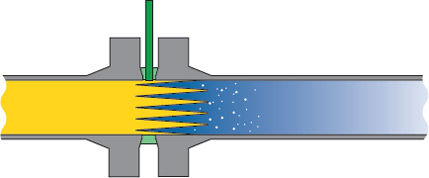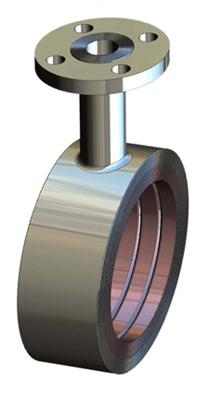Mechanical Spray Desuperheater (MSD)
This is the simplest type of Desuperheater, consisting of a fixed area nozzle arranged to face the steam flow through periphery of Desuperheating pipe. The MSD relies on the pressure differential available across the jets to achieve the conditions for rapid absorption of the water into the steam.
A cooling water Control Valve installed in the water line ahead of the MSD will vary the water supplied to the jets. This maintains the downstream steam temperature at the measuring point. Whilst the MSD is working between approximately 5% and 100% of maximum rated capacity, there will be adequate pressure differential across the jets to ensure a spray pattern in the form of a hollow cone of finely divided water particles. When Desuperheating loads go above the maximum rated capacity, the steam velocity at the exit of the nozzle will ensure turbulent flow, which helps to mix water particles into the steam thoroughly.
With reduction in steam flow, the steam velocity and turbulence will also reduce. The reduced steam flow of the water requirement will also be proportionately reduced in order to maintain the constant temperature. The plug of the Control Valve will automatically move towards the closed position to achieve this.
Given the spray jets have a fixed orifice; the pressure differential across them will reduce proportionally to square off the reduction flow in accordance with Bernoulli’s law. This causes a reduction in differential velocity between the steam and the water particles, a reduction in the cone angle so that the water is projected more directly downstream, and an increase in water droplet size. All of these phenomena adversely affect the ability of the Desuperheater to work efficiently.
MSD relies on the pressure drop across the spray jets to achieve the necessary atomization. The unit consists of an orifice plate jet through which the water is discharged and the pressure drop across this creates a spray pattern to achieve the necessary atomization. The Desuperheater can only be designed for maximum flow conditions and since the pressure drop across the jet hole follows square laws, as the flow is reduced, the pressure drop across the jet hole is substantially reduced and the atomizing characteristic is rapidly lost. For example, if the flow is reduced by 50% of pressure drop across the orifice is reduced by 4.
If the load further reduces, a stage would be reached where the spray jet ceases spraying and the water is projected straight downstream and collects at the bottom of the steam pipe. Since the steam is not being desuprerheated, the temperature senses a rise in steam temperature, the Control Valve plug moves towards the open position, and the jet commences to spray again. The steam is thus overcooled, which causes the Control Valve to close again. The whole cycle then repeats with consequent swings in temperature and intermittent flooding of the steam line with cooling water.
Many attempts have been made to produce a nozzle that has better rangeability, such as a swirl nozzle. However, such nozzles still suffer from the fact that as steam and water flow reduces, Desuperheating efficiency falls away proportional to the square of the flow. More recently, different variable nozzle spray Desuperheater designs have been attempted. In these designs MASCOT has attempted to maintain a constant water pressure differential that ensures effective atomization, a wide angle cone, and high water velocity at all loads, changing the orifice area proportionally to load varies throughout. However, the MSD is widely used with successful results in installations where the load is relatively steady. The inevitable variation in the steam temperature downstream of the Desuperheater and the water, which is collected and trapped out, of low order are acceptable.
For MASCOT to design the most efficient Desuperheater we require the following parameters:
- Operating pressure of steam
- Maximum inlet temperature of steam**
- Required outlet temperature of steam
- Steam flow rate**
- Available cooling water pressure
- Available cooling water temperature
** You can give all possible values for these parameters

Mechanical Spray Desuperheater (MSD) Standard Installation


